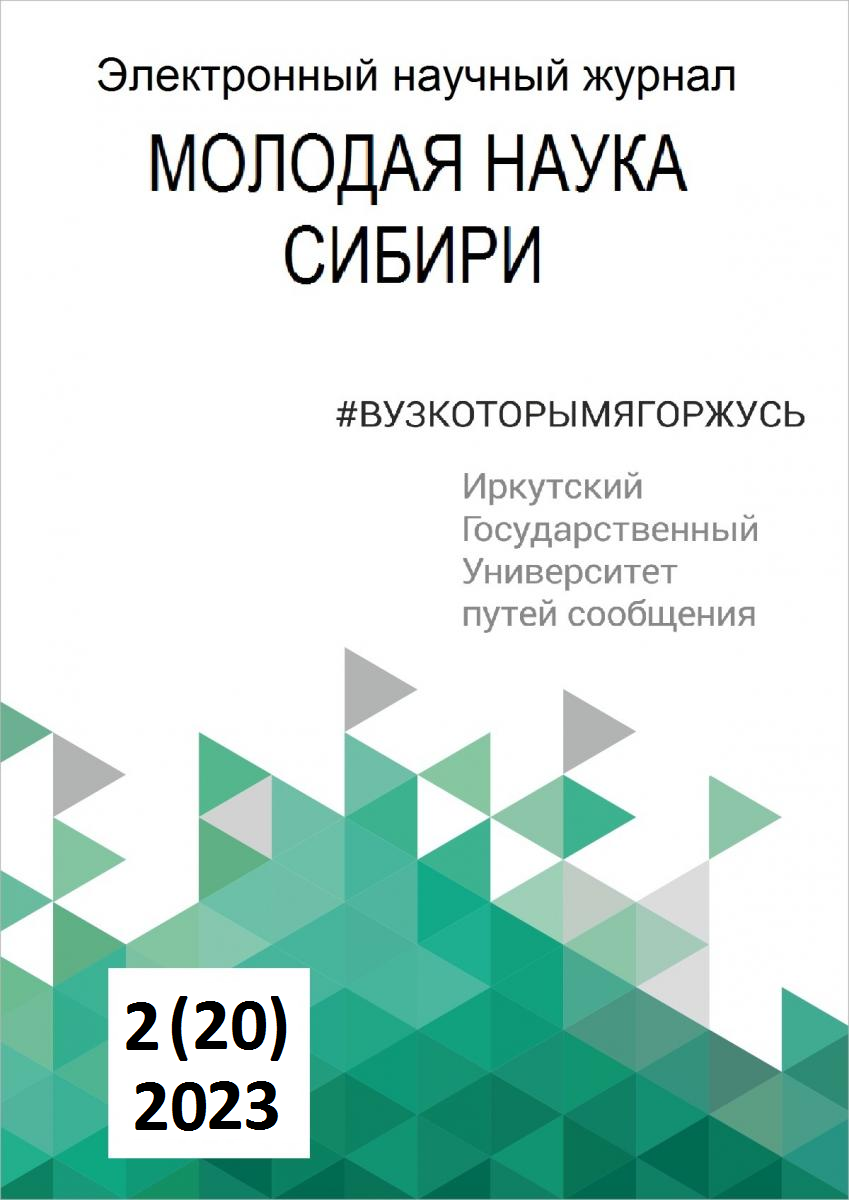DEVELOPMENT OF SOFTWARE FOR STUDYING THE GEODYNAMICS OF THE BAIKAL RIFT ZONE
Keywords:
Baikal rift zone, earthquake prediction, spectral analysis, geodynamics, mantle plumes, software developmentAbstract
Since the Irkutsk region has a very developed transport and economic industries, one of the most important aspects of their development and operation is the seismic zoning of transport infrastructure and taking into account the risks from the effects of earthquakes in the territory of the Baikal region. To solve such problems, starting in 2012, Irkutsk State University of Communications and the Institute of the Earth's Crust SB RAS have been conducting research aimed at finding methods for predicting seismic activity and studying geodynamics of the Baikal Rift Zone (BRZ). As a result of the research carried out, a method of medium-term forecasting of seismic activity was developed, based on the processing of statistical data on the helium content in groundwater. The proposed method has shown its high efficiency in the absence of missing events of seismic activity and false positives.
There is an assumption that one of the reasons for the seismic activity of the Baikal region is the influence of the Baikal mantle plume. However, until now, the very existence of the Baikal mantle plume has not been proved instrumentally due to the high cost of the necessary research. The practical application of the method of medium-term forecasting of seismic activity proposed by the authors has shown that it can also be used for the study of deep geodynamics. The method of geodynamics is the spectral analysis of the stress of the Earth's crust. The results obtained can be considered as proof of the existence of the Baikal plume.
In order to predict earthquakes and study geodynamics, it became necessary to develop special software for processing statistical data on the helium content in groundwater. This article is devoted to the development of this software.
References
Nataf H.C. Seismic imaging of mantle plumes. Annu. Rev // Earth Planet. Sci., 2000, v. 28, p. 391–417.
Clague D.A., Dalrymple G.B. Geologic evolution: The Hawaiian-Emperor volcanoc chain // Volcanism in Ha-waii. Washington: Governmental printong office, 1987, р. 5-54.
Wilson J.T. A possible origin of the Hawaiian Islands // Canad. J. Phys., 1963, v. 41, p. 863—866.
Courtillot V., Davaille A., Besse J., Stock J. Three distinct types of hotspots in the Earth’s mantle // Earth Planet. Sci. Lett., 2003, v. 205, p. 295—308.
Кузьмин М.И., Ярмолюк В.В. Мантийные плюмы Северо-Восточной Азии и их роль в формировании эн-догенных месторождений // Геология и геофизика, 2014, т. 55, № 2, с. 153—184.
Марков А. Формирование сибирских траппов сопровождалось горением большого количества камен-ного угля // Некоммерческий научно-популярный проект «Элементы большой науки», Новости науки. URL: https://elementy.ru/novosti_nauki/433670/Formirovanie_sibirskikh_trappov_soprovozhdalos_goreniem_bolshogo_kolichestva_kamennogo_uglya
Арзамасцев А. А. и др. Палеозойский толеитовый магматизм в Кольской провинции: ареал распро-странения, возраст, связь со щелочным магматизмом/ А. А. Арзамасцев, Р. В. Веселовский, А. В. Травин, Д. С. Юдин, Б. В. Беляцкий // Петрология, 2017, том 25, № 1, с. 46–70
DEEP GEODYNAMICS AND MANTLE PLUMES: THEIR ROLE IN THE FORMATION OF THE CENTRAL ASIAN FOLD BELT. Yarmolyuk V.V., Kovalenko V.I. Petrology. 2003. Т. 11. № 6. p. 504-531.
Kuzmin M.I., Yarmolyuk V.V., Kravchinsky V.A., Phanerozoic hot spot traces and paleogeographic recon-struc-tions of the Siberian continent based on interaction with the African large low shear velocity province // Earth Science Rev., 2010, v. 102, № 1—2, p. 29—59.
Кузьмин М.И., Ярмолюк В.В. Глубинная геодинамика, или как работает мантия Земли // Наука из первых рук, 2011, № 6(42), с. 19—35.
Логачев Н.А. История и геодинамика Байкальского рифта // Геология и геофизика, 2003, т. 44, № 5, с. 391-406.
Кашковский В.В., Семёнов Р.М., Лопатин М.Н. Применение системного подхода для разработки ме-тодов прогноза землетрясений // Современные технологии. Системный анализ. Моделирование, 2017, вып. № 2(54), с. 95-103.
Семенов Р.М., Кашковский В.В., Лопатин М.Н. Гидрогеохимический предвестник землетрясений в Южном Прибайкалье // Геология и геофизика, 2017, № 5, с. 18-28.
Семенов Р.М., Кашковский В.В., Лопатин М.Н. Модель подготовки и реализации тектонического землетрясения и его предвестников в условиях растяжения земной коры // Геодинамика и тектонофизика, 2018, т. 9, № 1, с. 165–175.
Саньков В.А., Леви К.Г., Кале Э., Девершер Ж., Лесне О., Лухнев А.В., Мирошниченко А.И., Буддо В.Ю., Залуцкий В.Т., Башкуев Ю.Б. Современные и голоценовые горизонтальные движения на Байкальском геодинамическом полигоне // Геология и геофизика, 1999, т. 40, № 3, с. 422-430.
Соболев Г.А. Основы прогноза землетрясений. М., Наука, 1993, 313 с.
Scholz C.H., Sykes L.K., Aggarwal Y.P. Earthquake prediction: a physical basis // Science, 1973, v. 181, p. 803-810.
Ржевский В.В., Новик Г.Я. Основы физики горных пород: Учебник для вузов, 4-е изд., перераб. и доп. М., Недра, 1984, 369 с.
Горная энциклопедия. URL: http://www.mining-enc.ru/p/prochnost, 2023.


